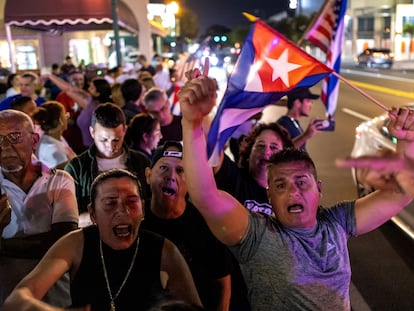Mothers are the main opposition to the Cuban regime
Several recently demonstrated outside President Miguel Díaz-Canel’s house. Most of Cuba’s protests in recent times have been driven by women like them

The day Nidia Noruega stood with her children outside the house of the president of Cuba, she was wearing a red fake Moschino pullover and a white headscarf, and carrying an insult she had harbored for years. Nobody knew exactly where Miguel Díaz-Canel’s house was, until Nidia and three other mothers, along with a gang of rowdy children, set out a few days ago to look for an answer that they have still not received.
The whereabouts of Díaz-Canel’s house, like those of all Cuban leaders, has always been a mystery, until it was found by people who have no home. In Cuba, there are no official residences like the White House. It was always known that Fidel Castro and his family lived in Punto Cero, in the most distant area of the municipality of Playa, to the west of Havana, on the grounds of a former golf course — a place that not even we Cubans try to imagine. Punto Cero was so far away, it really seemed outside the margins of Cuba.
Diaz-Canel’s home is located on the grounds of the former Biltmore Yacht & Country Club, just off 146th Avenue. Nidia didn’t come across it recently, but a few years ago when she was taking her children to the beach. She saw several cars and asked a guard what was going on in the area. He told her it was the vicinity of the president’s house. From a distance, she could make out a swimming pool and a wide expanse of land, but not much more because she has never been allowed beyond the gatehouse. Nidia has not seen the house, but she says it is a mansion. Nidia has never seen a mansion, but she imagines what one is like, despite it being something she doesn’t get to see. The first time she stood up to demand housing in front of the Cuban president’s house, her youngest daughter was one year old. Now she is seven and still homeless.
On the most recent of her visits, she and her companions recorded a video that they spread on social networks, in which they say they can’t take it anymore. Not only are they homeless in a city where, according to official figures, 1,000 houses collapse every year and where 600,000 people live in almost uninhabitable places: they also say they are hungry.
Most of the protests in Cuba in recent times have been driven by women. Not only the mass ones or those that attract media attention — such as those of July 2021 or March 2024 — but also the more unprecedented or fleeting ones, those of the day-to-day. Women in Cuba are the ones who constantly take to the streets. Their struggle does not have only one face, nor only one aim. They have been seen demanding basic needs such as food, water, electricity, healthcare, or housing, which have been at the center of the dissatisfaction of Cuban citizens in recent years.
There is the Cuban mother who sat with her two daughters and several empty containers in the middle of a street in Old Havana, as a protest against the shortage of drinking water and power cuts. Or the mothers of Maisí, who went out with water tanks, empty after so many days without supplies. There is the mother who went to the municipal government of Marianao in search of milk, with her child in her arms and a devastating cry. There are the mothers outside the Cuban Ministry of Public Health, with their children suffering serious illnesses that no one is attending to.
At the age of 18, Nidia left her mother’s house, where 20 people live in one room, with her first newborn child. She went to a shelter, where she stayed for three years. She also once snuck into a court facility. She spent some time on the streets with the children. She moved on to another shelter where her other four children, who don’t know what it’s like to have a home, were born.
“My children have always lived in shelters, ever since they were born,” says Nidia, now 32, who cleans floors at the provincial government headquarters, where she has been threatened with eviction if she continues to visit the area around the president’s house.
After 15 years of living in shelters, Nidia is now in transit housing, a place that gets wet when it rains, that floods with water from the ditches, and that the government has given her while promising her a house that has not yet materialized. Tired of waiting for the government to act, Nidia has stood outside Díaz-Canel’s home on four occasions.
“I can’t take it anymore,” she says. “I want to take a pack of pills and be taken to the Military Hospital. And when I get to the Military Hospital, I’ll already be dead; they’ll say that Nidia has already died.”
At the gatehouse of the president’s house, she and the rest of the mothers were told that it is prohibited to be there, to cross the limits between people and power, as the government has always guaranteed. After a while, the police and officials from the Department of Minors arrived, placed them in a patrol car, and cleared the area. At Nidia’s last police summons, an officer asked her if she knew that “incitement” is punishable by up to three years in jail. Nidia replied that she was not inciting anyone. The officer told her not to come back, that she and her companions would end up behind bars.
“I told him, ‘Well, give me 30 years, because I’m going to keep going,’” Nidia says. As long as she has no home, she will return to Díaz-Canel’s. There, or elsewhere on the island, there will always be a mother knocking on his door.
Sign up for our weekly newsletter to get more English-language news coverage from EL PAÍS USA Edition
Tu suscripción se está usando en otro dispositivo
¿Quieres añadir otro usuario a tu suscripción?
Si continúas leyendo en este dispositivo, no se podrá leer en el otro.
FlechaTu suscripción se está usando en otro dispositivo y solo puedes acceder a EL PAÍS desde un dispositivo a la vez.
Si quieres compartir tu cuenta, cambia tu suscripción a la modalidad Premium, así podrás añadir otro usuario. Cada uno accederá con su propia cuenta de email, lo que os permitirá personalizar vuestra experiencia en EL PAÍS.
¿Tienes una suscripción de empresa? Accede aquí para contratar más cuentas.
En el caso de no saber quién está usando tu cuenta, te recomendamos cambiar tu contraseña aquí.
Si decides continuar compartiendo tu cuenta, este mensaje se mostrará en tu dispositivo y en el de la otra persona que está usando tu cuenta de forma indefinida, afectando a tu experiencia de lectura. Puedes consultar aquí los términos y condiciones de la suscripción digital.
More information
Archived In
Últimas noticias
Most viewed
- Reinhard Genzel, Nobel laureate in physics: ‘One-minute videos will never give you the truth’
- Oona Chaplin: ‘I told James Cameron that I was living in a treehouse and starting a permaculture project with a friend’
- Pablo Escobar’s hippos: A serious environmental problem, 40 years on
- Charles Dubouloz, mountaineering star, retires at 36 with a farewell tour inspired by Walter Bonatti
- Why we lost the habit of sleeping in two segments and how that changed our sense of time











































